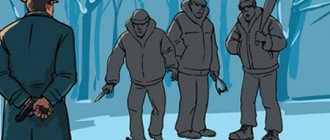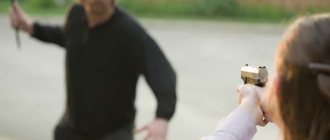New edition of Art. 37 of the Criminal Code of the Russian Federation
1. It is not a crime to cause harm to an attacker in a state of necessary defense, that is, when protecting the personality and rights of the defender or other persons, the legally protected interests of society or the state from a socially dangerous attack, if this attack was associated with violence dangerous to the life of the defender or another person, or with an immediate threat of such violence.
2. Protection from an attack that is not associated with violence dangerous to the life of the defender or another person, or with an immediate threat of such violence, is lawful if the limits of necessary defense were not exceeded, that is, deliberate actions that are clearly inconsistent with the character and the danger of encroachment.
2.1. The actions of a defending person do not exceed the limits of necessary defense if this person, due to the surprise of the attack, could not objectively assess the degree and nature of the danger of the attack.
3. The provisions of this article apply equally to all persons, regardless of their professional or other special training and official position, as well as regardless of the ability to avoid a socially dangerous attack or seek help from other persons or authorities.
Characteristics of the concept
The concept of self-defense in the Criminal Code of the Russian Federation is presented as causing harm to another person while trying to protect one’s legal rights and personality. To qualify a person’s actions as self-defense, there must be a direct threat of violence or an immediately dangerous attack. In this case, the threat must be noted from the beginning of the attack until its completion. The danger must be real, and not imaginary, that is, it must really exist in fact, and not in the imagination of the defending person.
To understand the specifics of qualifying actions under Article 37, we can consider an example in which a drunken Sidorov decided to play a joke on his neighbor. He waylaid him as he left the kitchen, pointing a child's crossbow at him. A neighbor, leaving the kitchen in a communal apartment, was holding a knife in his hands; when he saw a crossbow aimed at himself, he threw the knife at the drunken intruder. In this situation, the threat to life was not real; accordingly, the person who threw the knife will be held accountable for causing moderate injuries.
Article 37 of the Criminal Code of the Russian Federation will be charged if, during the beating, the victim grabs a knife and thrusts it into the offender. She should do this precisely at the moment of striking her, but not after the attacker stopped beating her and left, and not before he touched her for the first time.
There are two types of necessary defense, one related to exceeding limits and the other not related to them. Determining the type of self-defense is very important, because it has a direct impact on the qualification of actions and the choice of punishment.
There are certain conditions for the legality of protecting your life.
These include:
Punishment for exceeding the limits of self-defense and the corpus delicti under the Criminal Code of the Russian Federation, Article 108
- the purpose of causing harm to another person should be solely protection from attack, not punishment or retribution;
- a defending person can protect from encroachment not only his interests and rights, but also the interests and lives of third parties;
- harm from self-defense must be aimed exclusively at the attacker;
- harm to the attacker in the process of self-defense must be caused taking into account the nature of his attack.
An example of a necessary defense in criminal law would be a situation in which, while walking in the park, a guy and a girl noticed a fight. One of the fighters was a policeman. As the guy came closer, he noticed that the policeman had a knife sticking out of his stomach. The attacker pulled out a second knife and walked towards the girl, at which time the guy grabbed a pistol from the wounded law enforcement officer and shot at the attacker. The guy’s actions will be qualified as self-defense, because there was a real danger of causing bodily harm to the girl, and he had the right to protect the lives of third parties from a dangerous act.
The legislation does not provide for mandatory compliance with the principle of proportionality. That is, the court will not take into account the fact that the attacker wielded a knife, but was stopped by a firearm.
Self-defense is considered legal if it is directed against the actions and inactions of the offender, for example, if a railway station employee did not move the switch, which led to a train crash. The necessary defense can be directed against both intentional and unintentional attacks. It is very important to note that the victim has the right to defend himself, even if the attacker is a minor, but it is necessary to provide such a confrontation that will cause the least harm to the minor.
Defense that is directed against the actions of law enforcement officials is not considered justified. Upon arrest, resistance will be regarded as disobedience to the police and will entail criminal liability. It is not considered legal to resist when provoking an attack for reprisal under the guise of self-defense.
Article 37. Necessary defense
- home
- Laws and regulations
- Criminal Code of the Russian Federation
- Article 37. Necessary defense
1. It is not a crime to cause harm to an attacker in a state of necessary defense, that is, when protecting the personality and rights of the defender or other persons, the legally protected interests of society or the state from a socially dangerous attack, if this attack was associated with violence dangerous to the life of the defender or another person, or with an immediate threat of such violence.
2. Protection from an attack that is not associated with violence dangerous to the life of the defender or another person, or with an immediate threat of such violence, is lawful if the limits of necessary defense were not exceeded, that is, deliberate actions that are clearly not consistent with the character and the danger of encroachment.
2-1. The actions of a defending person do not exceed the limits of necessary defense if this person, due to the surprise of the attack, could not objectively assess the degree and nature of the danger of the attack.
3. The provisions of this article apply equally to all persons, regardless of their professional or other special training and official position, as well as regardless of the ability to avoid a socially dangerous attack or seek help from other persons or authorities.
Commentary on Article 37
Necessary defense is an inalienable right of the individual. The Constitution of the Russian Federation (Part 2 of Article 45) recognizes the right of everyone to defend their rights and freedoms by all means not prohibited by law. The purpose of necessary defense, its significance is to protect the individual, society and the state from socially dangerous attacks. The right to defense is a natural right of any person, regardless of professional or other training. Any citizen can exercise the right to necessary defense, but the law does not oblige him to exercise this right. With the necessary defense, harm is caused to the attacker. Formally, such actions fall under the signs of a criminal act. But the actions of the defender are not socially dangerous. Moreover, they are socially useful, encouraged by the state, since they are not only aimed at protecting legally protected interests, but also contribute to increasing the social activity of citizens. The institution of necessary defense is designed to ensure the rights of the defenders and other subjects from socially dangerous attacks, to protect the defender from possible unjustified prosecution for committing a crime, including for a crime associated with exceeding the limits of necessary defense.
According to Part 1 of Art. 37 of the Criminal Code of the Russian Federation it is not a crime to cause harm to an offender in a state of necessary defense, i.e. when protecting the personality and rights of the defender or other persons, the legally protected interests of society or the state from a socially dangerous attack, if this attack was associated with violence dangerous to the life of the defender or another person, or with an immediate threat of the use of such violence.
From the content of this norm it follows that if a socially dangerous attack was associated with violence dangerous to the life of the defender or another person, or with an immediate threat of the use of such violence, then the necessary defense will be lawful regardless of what means and methods were used to defense and what harm was caused to the attacker. The law recognizes in such cases the legality of causing any harm, up to and including causing death. Thus, in fact, we are talking about the absence of any restrictions (with some exceptions, which will be discussed below) when protecting such an object as human life. This prevents the limits of necessary defense from being exceeded in such situations.
The socially dangerous attack in question must be associated with violence dangerous to the life of the defender or another person, or with an immediate threat of such violence. In this case, the danger to life must be objectively existing and real. Otherwise, the actions of the defender may be regarded as imaginary defense, which entails criminal liability, or if the defender is in good faith and there is reason to believe that there is a danger to life, the actions of the defender should be assessed as innocent causing of harm.
Protection from an attack that is not associated with violence dangerous to the life of the defender or another person, or with an immediate threat of such violence, is lawful if the limits of necessary defense are not exceeded, i.e. intentional actions that are clearly inconsistent with the nature and danger of the attack.
In this position, established by Part 2 of Art. 37 of the Criminal Code of the Russian Federation, the legislator focuses on the following points. First: when protecting objects other than human life, the restrictions established by law must be observed. At the same time, it should be borne in mind that in some cases, causing death in the absence of an assault involving violence dangerous to the life of the defender or another person, or with an immediate threat of such violence, may also be lawful. For example, a woman causing death to her attacker during rape should be recognized as lawful.
When deciding whether there is violence dangerous to life, one should take into account the explanations of the Resolution of the Plenum of the Supreme Court of the Russian Federation dated December 27, 2002 N 29 “On judicial practice in cases of theft, robbery and robbery” that under violence dangerous to life life or health, it should be understood as such violence, which entailed the infliction of grave and moderate harm to the health of the victim, as well as the infliction of minor harm to health, causing a short-term health disorder or a minor permanent loss of general ability to work, or which, although did not cause harm to the health of the victim, nevertheless the moment of application created a real danger to his life or health.
Second: failure to comply with these restrictions specified in the law, i.e. exceeding the limits of necessary defense must consist of deliberate actions that are clearly inconsistent with the nature and danger of the attack.
As is known, in accordance with Art. 25 of the Criminal Code of the Russian Federation, a crime is recognized as committed intentionally if the person was aware of the social danger of his actions (inaction), foresaw the possibility or inevitability of socially dangerous consequences and wanted them to occur or did not want them, but consciously allowed these consequences or was indifferent to them. In this regard, it should be concluded that in the case of an attack that is not associated with violence dangerous to the life of the defender or another person, or with an immediate threat of the use of such violence, exceeding the limits of necessary defense is associated with the defender’s awareness of the wrongness and danger of his actions at the time of infliction harm. In other words, the defender must clearly realize that he has the opportunity to protect himself from an attack and stop it by using other means of defense, with less intensity, causing significantly less harm to the attacker compared to what was actually caused. Thus, the defender should strive not to reprisal the attacker, but to stop his actions and cause only the harm necessary to repel the attack. But at the same time, the ability of the defender to run away, call for help, or otherwise evade the attack has no legal significance. The presence of such a possibility should in no case be regarded as a factor in exceeding the limits of necessary defense.
In Part 2.1 of Art. 37 of the Criminal Code of the Russian Federation states that the actions of a defending person do not exceed the limits of necessary defense if this person, due to the surprise of the attack, could not objectively assess the degree and nature of the danger of the attack. In such situations, in the absence of an objective assessment of the circumstances of the attack, there is no intent to exceed the limits of necessary defense, and therefore causing harm in such situations is recognized as legitimate.
All persons have the right to necessary defense equally, regardless of professional or other special training and official position. This right, as noted above, belongs to the person and regardless of the ability to avoid a socially dangerous attack or seek help from other persons or authorities.
This provision, enshrined in Part 3 of Art. 37 of the Criminal Code of the Russian Federation, clarifies the provision on necessary defense in relation to persons whose professional duties include the suppression of socially dangerous attacks.
So, in Art. 24 of the Law of the Russian Federation of April 18, 1991 N 1026-1 “On the Police” contains a provision that the activities of a police officer are subject to the norms of the criminal legislation of the Russian Federation on necessary defense, causing harm when detaining a person who has committed a crime, extreme necessity, physical or mental coercion, about reasonable risk, execution of an order or instruction. At the same time, the prevention and suppression of crimes and administrative offenses are the responsibility of the police, in the performance of which, in cases established by law, police officers have the right to use physical force, special means and firearms <1>.
———————————
<1> Gazette of the SND and Supreme Soviet of the RSFSR. 1991. N 16. Art. 503.
Similar legislative provisions exist for employees of a number of other services. The general right to necessary defense, including that of said employees, cannot be limited. Therefore, in case of conflict of other legislative acts with the provisions of Art. 37 of the Criminal Code of the Russian Federation, the provisions of the latter must be applied. However, this does not exclude the need to take into account, when deciding on the necessary defense, such factors as the physical and psychological training of police officers and other persons, the availability of special equipment and weapons.
The right to necessary defense cannot but have boundaries that determine the state of necessary defense and separate this state from the state of exceeding its limits. The legality of the necessary defense is determined by a number of signs, which are usually divided into two groups:
a) related to the encroachment;
b) related to protection.
The circumstance of the legality of the necessary defense related to the encroachment is, first of all, the social danger of the latter, which is expressed in causing harm or the possibility of causing harm to social relations protected by criminal or other law. Here it is necessary to pay attention to the fact that, regulating the institution of necessary defense, the legislator focuses on the factor of public danger, and not the criminality of the attack. This approach means that the necessary defense can also take place in cases where the rights and legitimate interests of an individual, society, or state are violated not only by a crime, but also by another socially dangerous attack, for example, an attack belonging to the category of administrative offenses. In addition, there is a public danger in the unlawful actions of officials. Therefore, subject to other conditions established by law, the necessary defense is possible against such attacks.
A person who deliberately caused an attack in order to use it as a pretext for committing illegal actions (starting a fight, committing reprisals, committing an act of revenge, etc.) cannot be recognized as being in a state of necessary defense. What was done in such cases should be qualified on a general basis.
The second condition of legality is the existence of an encroachment. Establishing this circumstance is associated with determining the initial and final moments of the encroachment. The exercise of the right to necessary defense is possible only during the period of a socially dangerous attack. Thus, defense against a possible attack in the future will be unlawful. However, the state of necessary defense arises not only at the very moment of a socially dangerous attack, but also in the presence of a real threat of attack. The state of necessary defense can also occur when the defense followed immediately after the act of at least a completed encroachment, but due to the circumstances of the case, the moment of its completion was not clear to the defender. In this case, for example, the transfer of weapons or other objects used in the attack from the attacker to the defender cannot in itself indicate the end of the attack.
The actions of the defender who caused harm to the attacker cannot be considered committed in a state of necessary defense if the harm was caused after the attack was prevented or completed and the use of means of defense was clearly no longer necessary. In these cases, liability arises on a general basis.
The validity or reality of an encroachment also refers to the conditions for the legality of the necessary defense and consists in the fact that defense is possible only from a real, objectively existing encroachment, and not from an encroachment that exists only in the imagination of the defender. This is how necessary defense differs from imaginary defense.
The conditions of legality related to protection include: 1) the presence of objects that can be protected by exercising the right to necessary defense; 2) causing harm only to the offender; 3) absence of actions that are clearly inconsistent with the nature and danger of the attack.
When deciding the presence or absence of signs of exceeding the limits of necessary defense, one should take into account not only the compliance or inconsistency of the means of defense and attack, but also the nature of the danger that threatened the defender, his strength and ability to repel the attack, as well as all other circumstances that could influence the real balance of power between the attacker and the defender (the number of attackers and defenders, their age, physical development, presence of weapons, place and time of the attack, etc.). When an attack is committed by a group of persons, the defender has the right to apply to any of the attackers such protective measures as are determined by the danger and nature of the actions of the entire group.
The actions of the defender cannot be considered as committed in excess of the limits of necessary defense and in the case when the harm caused by him turned out to be greater than the harm prevented and that which was sufficient to prevent the attack, unless there was a clear discrepancy between the defense and the nature and danger of the attack < 1>.
———————————
<1> On the issue of necessary defense, see also: Resolution of the Plenum of the Supreme Court of the USSR of August 16, 1984 No. 14 “On the application by courts of legislation ensuring the right to necessary defense from socially dangerous attacks” // Bulletin of the Supreme Court of the USSR. 1984. No. 5. Despite changes in legislation, many provisions of this Resolution are of practical importance at the present time.
The criminal law establishes liability only for the following acts committed when the limits of necessary defense are exceeded: murder (Part 1 of Article 108 of the Criminal Code of the Russian Federation) and intentional infliction of grievous bodily harm (Part 1 of Article 114 of the Criminal Code of the Russian Federation). Intentional infliction of grievous bodily harm resulting in death through negligence should also be qualified according to the specified norm. Establishing the range of acts, the commission of which in conditions of exceeding the limits of necessary defense may entail criminal liability, the legislator did not include among them the intentional infliction of minor harm to health and harm to health of moderate severity. Consequently, causing such harm to the attacker under no circumstances can be considered an excess of the limits of necessary defense due to the absence of a clear discrepancy between the protection and the nature and danger of the attack. Causing any harm to the offender through negligence is not such an excess.
Excess of self-defense
All actions of the defender must fit within certain limits of what is permitted; if these limits are exceeded, the defender will be recognized as a criminal. Excess of self-defense is qualified when the attacker suffered more harm than was necessary. Criminal liability for exceeding the necessary self-defense measures occurs if signs of a crime are found in the actions of the person who defended himself from the attack.
If a person, while offering resistance, was in a state where he could not assess the proportionality of his actions to the attack, he does not bear responsibility. The fact is that the state of inadequacy itself was caused by the assault; there is a direct cause-and-effect relationship. An example of this situation is an attempt by an adult man to rape a young adult girl. With his harassment, the criminal frightened the girl so much that in an attempt to avoid violence, she inflicted severe physical injuries on him with a stone. But the attacker did not use a weapon on her.
Exceeding the limits of self-defense is qualified under Article 114 of the Criminal Code of the Russian Federation or under Art. 108, if in the process of self-defense the attacker was killed. These two articles are imputed exclusively in the presence of direct intent. That is, the person defending himself must understand that the method of defense he has chosen does not correspond to the degree of danger and the nature of the harm caused to him. The indifference of the defender to the severity of the harm caused to the attacker will also be considered direct intent.
An example of exceeding self-defense measures would be a situation in which citizen Sidorova, while visiting citizen Ivanov, quarreled with the owner and decided to leave. Citizen Ivanov prevented her from leaving the apartment, but she took two knives from the kitchen and hit the owner in the hand with one of them, then left the apartment. On the staircase, citizen Ivanov caught up with her and began to choke her, at which time she used a second knife and stabbed the attacker in the heart, from which he died. Citizen Sidorov will be held accountable under Article 108 of the Criminal Code, since there is direct intent - she took two knives for defense. But the citizen did not pose any particular danger to her by preventing her from leaving the apartment.
Exceeding the limits of necessary defense in Article 114 of the Criminal Code of the Russian Federation
The situation with intent looked different when citizen Petrenko noticed that a thief was breaking into the window of his house and shot at the ceiling with a hunting rifle to scare off the intruder. The bullet ricocheted and hit the thief in the leg, from which the leg was subsequently amputated. In this situation, there is no direct intent; accordingly, the legislator does not provide for criminal liability. If, having noticed the thief, the owner of the house rushed to catch up with him, firing shots and hitting him in the leg, he would be brought to criminal liability, since he turned from a victim into an attacker.
Self defense concept
Know that this procedure is in place to protect your own safety: defensive actions cannot be stronger and more dangerous for the raider than a crime. Otherwise, your actions will be regarded as criminal.
Along with those who reject the proposed changes to the law, there is an opinion that there must be a balance between crime and defense, and this must be ensured by the state. But at the moment, criminals who attack people and their property with malicious intent are equated with completely respectable citizens who want to protect themselves and not give their property to crooks.
The amendments to the Self-Defense Law are aimed at preventing a huge number of planned raids in the future, which will save many lives.
How to prove self-defense?
Very often there are situations in which it is not enough to resist the attacker, but you also need to know how to prove self-defense in court in order to avoid liability. The importance of necessary defense in criminal law is enormous; no one can prohibit a person from taking advantage of the opportunity of self-defense. If you can correctly use this right, no one will blame you later for not wanting to resolve everything peacefully or not waiting for the police. If it turns out that you inflicted serious injuries on the attacker in self-defense, the first thing to do is to provide him with medical assistance and call an ambulance.
Do not run away under any circumstances, because leaving a person in danger is also a criminal offense.
From the point of view of the law, it does not matter whether the illegal act is carried out intentionally or through negligence. If they start strangling you in a dark entrance, the first thing you do is resist. You don’t have time to figure out whether this is a real criminal or a drunk neighbor who decided to play a joke on you. It is important that your resistance is timely, not premature, and not late. Of course, you shouldn't wait to get stabbed, but you should resist when there is a real threat.
In order to confirm this threat in court, try to remember what the criminal said at the time of the attack, how he behaved, remember, maybe someone saw your confrontation, describe in detail the circumstances of the attack, this is of great importance.
You will be provided with detailed advice on how to behave after the police arrive, and you must hire one. Before the police arrive, behave calmly, not aggressively, do not accuse the attacker of anything, the court will sort it out. Your aggressive behavior will be a sign that you feel guilty. If you understand that you have exceeded self-defense, but do not want to be held responsible for it, try to somehow make amends directly to the injured attacker. You can go to peace with him or compensate him for certain damage.
Unfortunately, there are many precedents in judicial practice when self-defense actually took place, but it was not the attacker who was convicted, but the person defending his rights and property. Everyone can determine the degree of seriousness of aggression and illegal intentions towards themselves in different ways. For some, the threat to life is considered as real, while others perceive it as a common occurrence. Our courts, as a rule, are far from wanting to establish the truth, so they make a decision that will be easier to argue.
Conditions for the legality of necessary defense
The topics covered are regulated by Article 37 of the Criminal Code of the Russian Federation. Necessary defense - forced infliction of damage to a criminal person while protecting one’s own life, health, interests, saving a person in need of help, if the attack was combined with violence, carried the threat of its use.
The defense is used exclusively against serious unlawful intentions, criminal attempt. It means the need for such decisions in the event of a planned or careless attempt, against active illegal behavior or, conversely, inaction, that is, the absence of such behavior. Protection is not excluded in case of actions of employees of various government agencies that are contrary to the law.
In a situation of self-defense from an attack by an unbalanced or minor person, it is worth remembering the moral side - to inflict the least amount of injury on the attacker with your techniques.
When saving another citizen from a criminal attack, the provisions of the article in question are applicable. For example, when saving a girl from the impending criminal attacks of an attacker.
Necessary defense in criminal law is considered not to contradict Article 37, if the following circumstances exist:
- aimed at counteracting socially threatening actions. It is unacceptable to carry out maneuvers to protect from lawful behavior or to oppose the performance of official duties. Measures taken in the event of provocation or targeted reprisal against an attacker under the pretext of forced defense will not be considered legal;
- when a person is forced to defend himself from an actual attack on a protected benefit. That is, the crime has already begun, is happening in real time, is causing damage, or there is a threat of an imminent assassination attempt in the coming seconds. Waiting for the attacker to strike first seems a completely legitimate decision, because we are talking about an actual attack, not a future one. In contrast to this scientific assumption, waiting can become a fatal mistake and lead to more serious consequences. BUT is not allowed at the end of the criminal influence, when the attacker’s goal has been achieved or the person has knowingly prevented the attempt;
- Harm must be caused to the person attempting to commit the attack, not to third parties to the conflict;
- the permissibility of one’s own defense when a criminal uses physical force is undeniable, and the prospects for such use when there is a risk of losing one’s life. No one has the right to destroy another person, life is the highest value protected by the state, proof of the legal nature of politics within the country;
- exposed to an attack, the victim may be very frightened, lose control over his actions, will be in a state of passion, will not be able to objectively assess what is happening, when fears for lives become in vain. For example, a defending citizen struck a criminal, as a result of which the latter dropped the knife - the weapon with which he was going to commit murder. The frightened victim grabs a heavy object at hand and delivers another blow, which becomes fatal to the attacker;
- To recognize the defense as legal, it must exclude exceeding permissible limits and be proportionate to the level of risk.
It is unacceptable to allow the death of a criminal subject who, due to his physical or psychological characteristics, will not be able to do the same in relation to his victim. Inflicting beatings, severe damage to health, or death to an attacker while protecting low-value items. For example, minors illegally entered the orchard and wanted to pick apples. The owner, in order to protect his harvest, hit one of the children on the head, as a result of which the latter died. The man was convicted of premeditated murder.
When defending one's own interests, the use of various weapons, mechanisms of influence, and animals is not prohibited, with the proviso that the influence will not harm other innocent persons, and excessive harm will not be caused to the perpetrator. Letting a dog off a leash in a park to scare away a criminal can be fraught with serious injury or death to the criminal, if the person loses control over the animal - visitors to the recreation area, including children. Fencing a plot of land with plantings with high-voltage barbed wire is also not a legal way to protect property that belongs to a citizen. The possible results of such work risk being disproportionate to the damage caused.
In case of group aggression against a citizen, it is allowed to cause harm to any member of the company for the purpose of their own salvation. During a collective fight, he is deprived of the opportunity to strike selectively.
What does the Criminal Code of the Russian Federation say?
The Criminal Code has Article 37 on exceeding the limits of necessary defense, and its essence is quite simple - this is the damage you caused to the criminal, which should not be greater than the harm that he caused to you. In such situations, law enforcement agencies adhere to certain rules; we consider them in the table below.
| Algorithm | Description |
| Step 1 | Find out whether there was really a threat to the victim’s life? |
| Step 2 | Could the defender run away and thus defend himself? |
However, it is difficult to figure out in an unforeseen situation whether you will exceed the threshold of your protection, which will automatically make you a criminal. Therefore, each situation is unique, and its outcome depends on the progress of the investigation and on what evidence you can provide in the case to defend yourself.
Self-Defense Law
It is proposed to adjust the law on self-defense in Russia in 2022, taking into account important amendments. The very definition of “self-defense” is quite controversial and gives rise to many discussions. The main thing that is proposed to be introduced is the lack of jurisdiction of the person defending his home.
Attention! The new definition of “necessary defense” means that those falling under Article 37 will not be punished, but will simply be released for lack of evidence of a crime. Thus, trespassing on someone else's property is a crime, but causing harm to the attacker is not.
Some consider this norm to be quite fair, since criminals today have become very unscrupulous and do not hesitate to kill home owners for the sake of profit.
Now the owner of his house is taking a great risk by deciding to protect himself from uninvited guests:
- He puts his life in danger in an altercation with thieves.
- Tries to defend himself and justify his actions before the investigation for possible exceeding the limits of self-defense.
Opponents of the innovation are sounding the alarm: such a “presumption of innocence” will give a free hand to many unbalanced people who want to hide typical everyday scandals with fatalities under this rule.
Peculiarity! Now attacking citizens with a toy gun is equivalent to robbery.
Example of a case of excess of self-defense
A high-profile incident occurred in Kaliningrad a couple of years ago. For an elderly pensioner, labor veteran, Egorova I.I. attacked by repeat offender Nikolaenko A.P. Born in 1980. He had previous convictions for robbery and assault. Nikolaenko A.P. broke into the apartment of a pensioner who lived there alone, took his savings and dealt him several strong blows to the body. Egorov I.I. was not taken aback and struck him back with a knife, after which the raider died on the spot.
The court recognized Egorov I.I. guilty of exceeding self-defense, which resulted in the death of the attacker. The sentence consisted of imprisonment of the pensioner for 5 years. This case received serious publicity, and society became agitated. What should Egorov I.I. do in this situation: defend himself or be bullied by the thief? The Court of Appeal overturned the decision of the first instance court and acquitted the pensioner.
However, such situations are rare in our judicial practice, and often a completely adequate defensive reaction can result in a long prison sentence for the defender.
You can understand how to avoid going to jail and understand the fine line between defense and attack by watching the video at the link below:
How to determine the scope of protection?
Next we will talk about how to establish the limits of necessary defense and what must be taken into account:
- first, determine the object of the raid, that is, what exactly the criminal was hunting for and what the defense side was protecting;
- how the perpetrator wanted to commit the attack and the severity of such an act in the end, whether there was a real reason to cause serious harm or death to the raider or whether it could have been avoided;
- where and when the attack was committed, whether the gang was armed, whether the perpetrator was alone or with a group of people;
- whether the defender could independently repel the attackers. Here, a person’s gender, age and physical characteristics play an important role;
- all other factors influencing the outcome of the situation and the court verdict against the parties.
Excess of self-defense
Exceeding one's defense is considered to be an obvious imbalance between the defense and the composition of the attack, and in this case, for no apparent reason, serious harm to health or even death of the attacker was caused. The person will answer only after it has been determined that the defendant deliberately caused serious injuries that were completely unnecessary to eliminate the danger to him or other people.
Important! A situation where a person deliberately causes damage to a criminal that is not nearly comparable to the harm that the criminal has already caused is considered an excess of self-defense standards. This entails criminal liability for illegal actions against the criminal.
What cannot be considered an excess?
Liability does not arise as a result of the unbalanced state of the victim, who cannot realistically accept the resulting harm from the delivered measures of protection.
You will not be convicted if you used weapons and other objects for the purpose of ensuring security against an armed person or gang, also when you prevented an illegal armed invasion of your property by these people, regardless of the degree of damage caused to the attacker.











